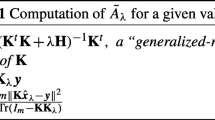Abstract
We first discuss the relativity of “true value and homogeneity” for quantitative remote sensing products (QRSPs), and then propose the definitions of “eigenaccuracy” and “eigenhomogeneity” under practical conditions. The eigenaccuracy and eigenhomogeneity for land surface crucial parameters such as albedo, leaf area index (LAI), and surface temperature are analyzed based on a series of experiments. Secondly, we point out the differences and similarities between the scale-free phenomena of the QRSPs and the measurements of the coastline length (1-dimensional) and the curved surface area (2-dimensional). An information fractal algorithm for the QRSPs is presented. In a case study for the LAI, when the fractal dimension is 2.16, the ratio of the LAI retrieval values obtained respectively from remote sensing data of 30 m and 6 km pixel resolution can actually reach as high as 2.86 for the same 6 km pixel using the same retrieval model. Finally, we propose an operational validation method “one test and two matches” and multipoint observation when the real situation does not allow carrying out scanning measurement without gap and overlap on the ground surface.
Similar content being viewed by others
References
Mandelbrot B B. Stochastic models for the earth’s relief, the shape and the fractal dimension of the coastlines and the numbered-area rule for islands. Proc Natl Acad Sci USA, 1975, 72: 3825–3828
Mandelbrot B B. The Fractal Geometry of Nature. San Francisco: Freeman Press, 1982
Becker F, Li Z L. Surface temperature and emissivity at various scales: Definition, measurement and related problems. Remote Sens Rev, 1995, 12: 225–253
Li X W, Alan S, Fried M. A conceptual model for effective directional emissivity from for non-isothermal surface. IEEE Trans Geosci Remote Sensing, 1999, 37: 2508–2517
Jaggi S, Dale A. Implementation of operation of three fractal measurement algorithms for analysis of remotes-sensing data. Comput Geosci, 1993, 19: 745–767
Zhao J, LI X H, Shan Y B. Fractal research of typical features remote sensing image in Beijing areas. Geomatics Spat Inf Technol, 2001, 24: 3–7
Zhang H G, Huang W L, Zhou C B, et al. Fractal characterization of IKONOS imagery. Bull Surv Map, 2005, 5: 15–18
Martinez V J, Paredes S, Borgani S. Bidirectional multiscaling properties of largescale structure in the universe. Science, 1995, 269: 1245–1247
Lam N S N. Description and measurement of Landsat TM images using fractals. Photogramm Eng Remote Sensing, 1990, 56: 187–195
Zhang R H, Li Z L, Tang X Z, et al. Study of emissivity scaling and relative of homogeneity of surface temperature. Int J Remote Sens, 2004, 25: 245–259
Chen J M. Spatial scaling of a remotely sensed surface parameter by contexture. Int J Remote Sens, 1999, 10: 1539–1561
Liang S L. Numerical experiments on the spatial scaling of land surface Albedo and leaf area index. Remote Sens Rev, 2000, 19: 225–242
Zhang R H, Tian J, Su H B, et al. A Measuring Device for Studying Scaling of Emissivities from Sub-pixel to Pixel. IEEE Proceedings Transactions Geoscience Remote Sensing Symposium, 2006
Kustas W P, Norman J M. Evaluating the effects of subpixel heterogeneity on pixel average fluxes. Remote Sens Environ, 1999, 74: 327–342
Zhang R H. A new model for estimating crop water deficiency based on infrared information. Sci China Ser B, 1987, 30: 413–425
Zhang R H, Sun X M, Zhu Z L, et al. A remote sensing model of CO2 flux for wheat and studying of regional distribution. Sci China Ser D-Earth Sci, 1999, 42: 325–336
Zhang R H, Sun X M, Liu J Y, et al. Determination of regional distribution of crop transpiration and soil water use efficiency using quantitative remote sensing data through inversion. Sci China Ser D-Earth Sci, 2003, 46: 10–22
Zhang R H, Sun X M, Wang W M, et al. An operational two-layer remote sensing model to estimate surface flux in regional scale: Physical background. Sci China Ser D-Earth Sci, 2005, 48(Suppl): 225–244
Gu X F, Yu T, Li X W. The radiometric cross calibration of the thermal infrared channels of the CBERS. Sci China Ser E-Tech Sci, 2005, 35(Suppl): 155–165
Author information
Authors and Affiliations
Corresponding author
Rights and permissions
About this article
Cite this article
Zhang, R., Tian, J., Li, Z. et al. Principles and methods for the validation of quantitative remote sensing products. Sci. China Earth Sci. 53, 741–751 (2010). https://doi.org/10.1007/s11430-010-0021-3
Received:
Accepted:
Published:
Issue Date:
DOI: https://doi.org/10.1007/s11430-010-0021-3




